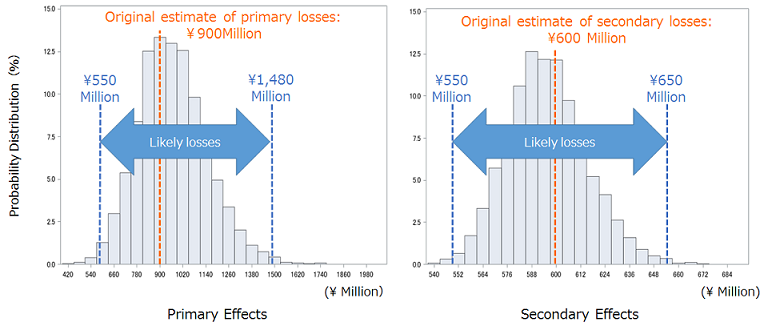Calculating the ripple effects of a shock as a range of possible outcomes
Input-output tables often lie at the heart of economic analysis that looks at the economic consequences of given shock.
One such application of the input-output table was in the research on the lost tourism in Ishinomaki region following the Great East Japan Earthquake (Hasegawa, 2017).(*1) The research reported that the primary indirect effect on lost tourism in the area is likely to be around \900 million. The secondary, indirect effect is likely to be 600 million yen. Although the analysis provided some useful insights, there were a number of key shortcomings in the data used. Firstly, the input-output tables utilized in the research related to 2005 data. It is broadly agreed that the industrial structure of the economy has changed considerably since 2005 and has further changed following the Great East Japan earthquake. The fixed nature of the data means that the variations taking place in the industrial structure of the economy from one year to the next are not captured. The second shortcoming is that the regional input-output tables are based on national level data with very little regional disaggregation. Given this, there is very limited scope for regional level analysis of a shock. Combined the shortcomings imply that any impact analysis will only produce a fixed outcome rather than a range of likely outcomes which are consistent with the changes that have taken place in the region’s industrial structure in recent times.(*2)
Teikoku Data Bank in collaboration with Tokyo Institute of Technology's Deguchi Laboratory has been working on a project that uses Teikoku Databanks extensive inter-firm transactions data consisting of 1.8 million companies and 5.9 million transactions to compile more timely input-output tables at the regional level.(*3,4,5) Since company data held by Teikoku Databank are generally updated at least once a year it is possible to capture the change in the industrial structure over time.
Additionally, since company location information is known, it is possible to grasp the industrial structure of each region. The study on the expected losses from tourism in the Ishinomaki region was replicated using Teikoku Databank input-output tables. Furthermore, given the availability of regional level differences over time, the likely impact was calculated as a range. The analysis suggested primary indirect losses in the range of 550 yen - 1.48 billion yen. Secondary losses in the range of 550 yen - 650 million yen (See Figure 1). Given this, under the worst case scenario, the maximum losses from reduced tourism is likely to be 2.130 billion yen. Since the contribution of `personal services` industry to the regional GDP is in the ballpark of 15.6 billion yen, the maximum loss of 2.1billion yen will be a very large damage.
Figure 1: Estimated primary and secondary effects of lost tourism in the Ishinomaki region

Every day decisions are based on the optimization of various variables be it time, costs or profit, given the available information. Unconsciously or consciously a best-case and worst-case scenarios are computed for every decision. For example, when renting the car, the choice of the accompanying insurance depends on the ones driving history. If one is accustomed to driving and has not caused major accidents, one is likely to agree to a minimum insurance. In contrast, in the event of snow and the carriage of passengers, one might opt for a higher insurance to protect from likely damage. Even more mundane decisions, like choosing the train vs a car in order to save 30 minutes when attending an important interview, choosing to save a little at a time to fund a 300,000 yen holiday, the requirement for 3-4 persons given the complicated nature of the work are all decisions that balance the latent benefits and risks of everyday life and work. Similarly, government organizations are also required to effectively implement projects with a limited budget. In order to objectively implement a policy the best–case and worst-case scenario must be considered.
By effectively utilizing the data held by Teikoku Databank on private enterprises, it is not only possible to engage in active discussion on investment opportunities and risk management, but also use the data to evaluate the range of likely outcomes that are consistent with the changes that have taken place in recent times.
This article was prepared on basis of research undertaken by Osato and Hasegawa (2018). The research is still ongoing, so the construction of the input-output table based on the TDB data is not publically available.
Tokyo Institute of Technology, School of Computing, Deguchi Laboratory
TDB Advanced Data Solutions Division, Takaya Osato
Big Data Analytics TOP